英语:Unit-1-《A-Trip-to-Beijing.》Lesson5课件(3)(冀教版七年级下
小学英语冀教版(一起)五年级上册Unit 1 A trip to Beijing Lesson 5 学案 第
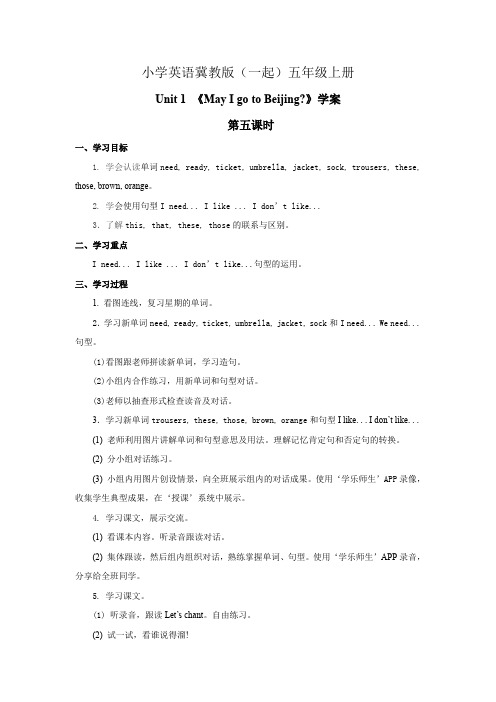
小学英语冀教版(一起)五年级上册Unit 1 《May I go to Beijing?》学案第五课时一、学习目标1. 学会认读单词need, ready, ticket, umbrella, jacket, sock, trousers, these, those, brown, orange。
2. 学会使用句型I need... I like ... I don’t like...3.了解this, that, these, those的联系与区别。
二、学习重点I need... I like ... I don’t like...句型的运用。
三、学习过程1. 看图连线,复习星期的单词。
2.学习新单词need, ready, ticket, umbrella, jacket, sock和I need... We need... 句型。
(1)看图跟老师拼读新单词,学习造句。
(2)小组内合作练习,用新单词和句型对话。
(3)老师以抽查形式检查读音及对话。
3.学习新单词trousers, these, those, brown, orange和句型I like...I don’t like...(1)老师利用图片讲解单词和句型意思及用法。
理解记忆肯定句和否定句的转换。
(2) 分小组对话练习。
(3) 小组内用图片创设情景,向全班展示组内的对话成果。
使用‘学乐师生’APP录像,收集学生典型成果,在‘授课’系统中展示。
4. 学习课文,展示交流。
(1) 看课本内容。
听录音跟读对话。
(2) 集体跟读,然后组内组织对话,熟练掌握单词、句型。
使用‘学乐师生’APP录音,分享给全班同学。
5. 学习课文。
(1) 听录音,跟读Let’s chant。
自由练习。
(2) 试一试,看谁说得溜!6.练习检查。
选择题,将正确的序号填在括号内。
()1.I like these trousers. A.你们都准备好了吗?()2.Are you ready? B.它是橙色和白色相间的。
优品课件之Unit 1 A Trip to Beijing

Unit 1 A Trip to Beijing Unit 1 A Trip to BeijingSkill Focus听说读写Language Focus功能句式词汇语法重点句子1.8 Lesson 8帮助学生复习运用本单元所学内容。
2. 课时分配Period 1 Lesson 1 May I Go to Beijing?Period 2 Lesson 2 May I Invite Danny and Jenny?Period 3 Lesson 3 How Far Is Beijing?Period 4 Lesson 4 How Can We Go to Beijing? Period 5 Lesson 5 Planning a tripPeriod 6 Lesson 6 Li Ming Packs His Suitcase Period 7 Lesson 7 At the Train StationPeriod 8 Lesson 8 Unit ReviewIII. Teaching plans for each period分课时教案Period 1 May I Go To Beijing?S: Yes. I’d like to go on a trip to Beijing. Step II PracticeS: No, you may not.Step III Text learningPeriod 2 May I Invite Danny and Jenny?Teaching procedures & ways 教学过程与方法Step I Lead-in and speakingPeriod 3 How Far Is Beijing?Period 4 How Can We Go to Beijing?Period 5 Planning a TripPeriod 6 Li Ming Packs His SuitcasePeriod 7 At The Train StationPeriod 8 Unit ReviewWhere do you like to travel? Why?How far is it?How do you like to travel? Why?JackBeijing. There are many interesting places. Two hundred and seventy eighty kilometers Take a train. It’s cheap and fast.TinaEdmonton. There are a lot of delicious foods. 9600 kilometers.Take a plane. It’s fast and fun.1. Sum up what they have learned in this unit.2. Go over the words and expressions in this unit and use some to write a short story or a dialogue.Teaching resourcesA personal list:Things that make me feel excited:- Preparing for guests优品课件- Seeing an incredibly attractive person- Fireworks- Meeting my favorite writer face to face- An invitation to dance- Going to the airport (departing for a trip)- The sound of the telephone ringing when I'm expecting my good friends to call- Scoring tickets for my favorite bandsThe things that make people feel excited vary from person to person―there's no one list or website that's goin g to have it all. I'll bet you can have your own great list-making.优品课件,意犹未尽,知识共享,共创未来!!!。
Unit1ATriptoBeijingLesson5
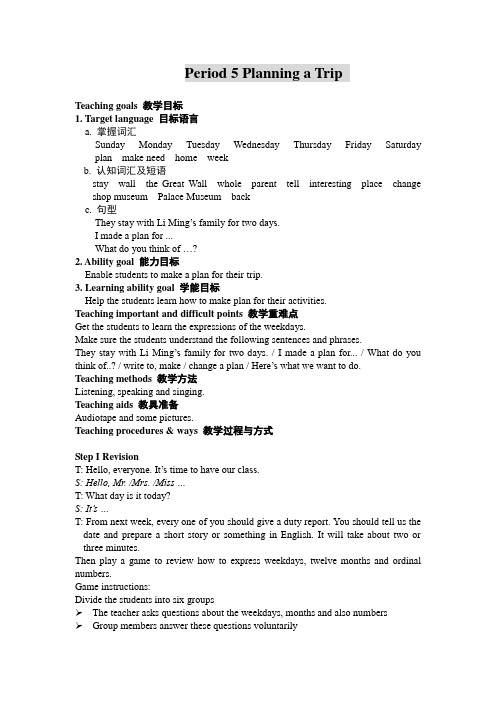
Period 5 Planning a TripTeaching goals 教学目标1. Target language 目标语言a. 掌握词汇Sunday Monday Tuesday Wednesday Thursday Friday Saturday plan make need home weekb. 认知词汇及短语stay wall the Great Wall whole parent tell interesting place change shop museum Palace Museum backc. 句型They stay with Li Ming’s family for two days.I made a plan for ...What do you think of …?2. Ability goal 能力目标Enable students to make a plan for their trip.3. Learning ability goal 学能目标Help the students learn how to make plan for their activities.Teaching important and difficult points 教学重难点Get the students to learn the expressions of the weekdays.Make sure the students understand the following sentences and phrases.They stay with Li Ming’s family for two days. / I made a plan for... / What do you think of..? / write to, make / change a plan / Here’s what we want to do.Teaching methods 教学方法Listening, speaking and singing.Teaching aids 教具准备Audiotape and some pictures.Teaching procedures & ways 教学过程与方式Step I RevisionT: Hello, everyone. It’s time to have our class.S: Hello, Mr. /Mrs. /Miss …T: What day is it today?S: It’s …T: From next week, every one of you should give a duty report. You should tell us the date and prepare a short story or something in English. It will take about two or three minutes.Then play a game to review how to express weekdays, twelve months and ordinal numbers.Game instructions:Divide the students into six groups➢The teacher asks questions about the weekdays, months and also numbers➢Group members answer these questions voluntarily➢Keep one point for the correct answer➢See which group gets the most pointsHere is one example:T: What day is the first day of the week?Group 1: Sunday.T: Great. One point for you. What is the month after March?Group3: April.T: That’s right. You’ve got one point. When is Children’s Day?Group2: It’s June first.T: Wonderful. You’ve got one point, too.…Step II Lead-in and language pointsExplain the following phrases and sentences to the students:make /change a plan / write home / interesting places / go shopping / What do you think of it?T: I am very busy every day. I made plans for my life, so I am very clear about what I will do every day. Do you like to make plans for your life? Why or why not?clear? ... Well, let me go on talking about my plans. On Sunday, I want to learn a new English song, then I can teach it to you next Monday. I think it’s interesting for you. What do you think of it?Help the students to answer.S: It’s …T: What do you want to do on Sunday?S: I want to watch TV.T: I think it’s a good idea. You can see many interesting places on TV, such as beautiful cities, amusement park and so on. And I want to go shopping this Sunday, because I have a lot of things to buy. And then, I will write to home. You see, I have already bought a letter. (Show the students the letter; make sure they understand what write home means.)T: (Turn to another student) What do you want to do?S: I want to play basketball.T: That’s great. I also want to play basketball with you, I change my plan and I will not write home. What do you think of it?S: That’s great.T: Is there any one want to go on a trip?S: Yes. I want to…T: That’s an interesting place. But it is too far away for you to go. Is there an interesting place in your town or city? What is it?Encourage the students to answer this question. Help them feel proud of their town or city.T: Good! I’d like to have a trip to those places. But you have to make a plan first, then we can have a good time. Will you? … Good! Li Ming made a plan. Let’s see how he made his plan.Step III Text learningGet the students to learn the text well.ListeningListen to the tape and answer the questions given.T: Li Ming likes to make a plan. He made a plan for his trip. Listen to the tape carefully please and answer the following questions:1.Where do they want to go? (They want to go to the Great Wall.)2.What do they do on Thursday in Li Ming’s plan? (They go to the Great Wall; Jenny and Danny write home.)3.What does Li Ming change in the plan? (They will go to the Great Wall on Thursday.)Then ask the students to listen to and repeat after the tape.PracticeGet the students to talk about Li Ming’s plan.T: Please look through Li Ming’s plan and then, ask and answer in turns with your partners about it. Let’s see who know it best.Sample dialogue:S1: What do they do on Monday?S2: They leave Shijiazhuang and arrive in Beijing. When do they go to the Palace Museum?S1: On Wednesday.…ApplyingAsk the students to work in groups of four and make a dialogue following this situation: A famous foreigner plans to go on a trip to China. A reporter interviews him or her to know about the plan. Sample dialogue:(S1: George W. Bush who will stay in Beijing for three days. S2: A reporter)S1: Welcome to China, President Bush.S2: Thank you. I am happy to be here.S1: We like to know your plan of your trip to China. What do you do on Monday?S2: I will meet Mr. Hu Jintao.S1: Beijing has many interesting places, will you meet some of them?S2: Yes.S1: Where do you want to go?S2: I want to go to the Great Wall on Tuesday.S1: Do you want to go shopping?S2: Yes. My daughters want to buy some delicious food on Wednesday. S1: That’s a good plan. Have fun in China.S2: Thanks a lot.Step IV Homework1.Finish off the exercise in Activity book.2.Practice reading this lesson.3.Make a plan for next week and write it down.4.Preview Lesson 6.。
小学英语冀教版(一起)五年级上册Unit 1 A trip to Beijing Lesson 5 课件 第
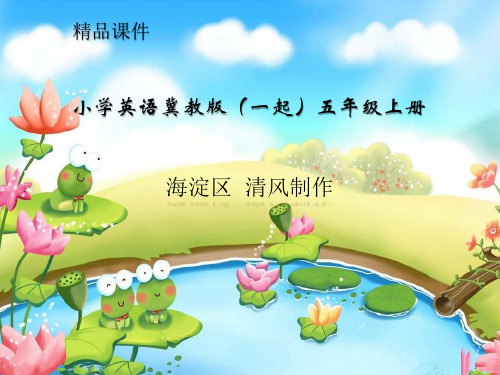
Practice
I like this dress.
It is new. It is blue.
Practice
I don’t like that dress.
It is blue and black.
Let’s chant! This is near, I have these.
That is far.
精品课件
小学英语冀教版(一起)五年级上册
海淀区 清风制作
冀教版一起小学英语五年级上册
Unit 1
Lesson 5 第五课时
Warming up
Tuesday Wednesday Thursday Monday Friday Saturday
星期六 星期三 星期一 星期四 星期二 星期五
Presentation
This is my ear,
Your have those.
These are my knees.
That is a star.
Those are your toes.
This, that, these, those. Near, far, now we know!
Summary
今天我们学习了单词 need, ready, ticket, umbrella, jacket, sock, trousers, these, those, brown, orange 。 还学习了句型I need... I like ... I don’t like...
Homework
1. 听录音,熟读本单元内容。使用‘学乐师
生’APP录音,分享给全班同学。
2. 朗读课文句子。和父母同学说一下你喜欢
和不喜欢的东西。
英语:Unit 1 《A Trip to Beijing(PPT)3-3.》Lesson5课件(3)(冀教版七年级下)

●Do you have a suitcase ?
Is it big or small ? What colour is it ? ● When you go on a trip, what
things do you like to take ?
或者吃发绿的马铃薯。致死的事件也不是突发的,当事人在食用后往往是起初虚弱无力,而后陷入昏迷。不用担心偶尔吃到的绿色马铃薯片,但一定要把长 了绿芽或表皮变绿了的马铃薯扔掉,不要再去烧煮食用,特别要小心别给儿童吃。 [] 马铃薯含有一些有毒的生物碱,主要是茄碱和毛壳霉碱,但一般经过℃ 的高温烹调,有毒物质;炒股入门 炒股入门 ; 就会分解。野生的马铃薯毒性较高,茄碱中毒会导致头痛、腹泻、抽搐,昏迷,甚至会导致死亡。 但一般栽培的马铃薯毒性很低,很少有马铃薯中毒事件发生。栽培马铃薯一般含生物碱低于.毫克/克,一般超过毫克才会导致中毒现象,相当于一次吃掉.公 斤生马铃薯。马铃薯储存时如果暴露在光线下,会变绿,同时有毒物质会增加;发芽马铃薯芽眼部分变紫也会使有毒物质积累,容易发生中毒事件,食用时 要特别注意。 [] 马铃薯(土豆)发芽后可产生较高的有毒生物碱——龙葵素(Solanine),食后可引起中毒。马铃薯中龙葵素的一般含量为~mg/g,如发芽、 皮变绿后可达~mg/g,能引起中毒。龙葵素在幼芽及芽其部的含量最多。当食入.~.g龙葵素时,就能发生严重中毒。 [] 孕妇经常食用生物碱含量较高的薯 类,蓄积在体内就可能导致胎儿畸形。当然,人的个体差异相当大,并非每个人食用了薯类都会发生异常,但是孕妇还是以不吃或少吃薯类为好,特别是不 吃长期贮存、发芽的薯类,这一点对处于妊娠早期的妇女来说尤其重要。 [] 中毒原因 引起发芽马铃薯中毒的主要原因是由于马铃薯贮藏不当,使其发芽或 部分变黑绿色,烹调时又未能除去或破坏龙葵素,食后便发生中毒。 [] 中毒症状 症状因服用量的多少表现轻重不一。主要表现如下,食后几小时内发病。 口腔内有烧灼和痒感、畏光、头痛、头晕、发热、呕吐、腹痛、腹泻、耳鸣等,进一步加重可能出现血压下降、烦躁不安、抽搐、呼吸困难、昏迷、瞳孔散 大等。 [] 急救措施 ①用筷子等刺激咽部催吐。多饮白水或糖水。 [] ②可服浓茶或喝些醋以分解龙葵素。 [] ③口服诸如:硫酸钠、硫酸镁等泻导泻。 [] ④ 病情严重者,急送医院。 [] 预防措施 ①不吃未成熟的青皮马铃薯。对于马铃薯上已经出现发芽、发青的部位或腐烂的部分要彻底清除。如果马铃薯的发青 面积较大,发芽部位也很多,就不能够再食用了。 [] ②去皮后的马铃薯要切成块、片或丝,放在冷水中浸泡,要泡半小时以上,能够使残存的茄碱充分溶解 在水中,减少毒素的残留。 [] ③利用茄碱弱碱性的特点,可以在烧马铃薯时放一些米醋,能
英语:Unit 1 《A Trip to Beijing(PPT)4-1.》Lesson5课件(3)(冀教版七年级下)

注意“a pair of +复数名词”作主语时谓语动词用单 数。
There is a pair of shoes under the chair . 在这把椅子下有一双鞋。
“pairs of +复数名词”作主语时,谓语动词用复 数。
Step 1: Think about it !
●Do you have a suitcase ?
Is it big or small ? What colour is it ? ● When you go on a trip, what
thing
亚硝酸盐的变化都是非常微小的。亚硝酸盐含量总体略有上升,对人体的影响来说是微乎其微的。 如何泡木耳才正确?更多 木耳可用凉水(冬季可用温水)泡 发。经过至小时的浸泡,水慢慢地渗透到木耳中,木耳又恢复到半透明状即为发好。这样泡发的木耳,不但数量增多,而且质量好。 内容整理 捉虫行动 中 文名 黑木耳; 虎牙业务 ; 学 名Auricularia auricula 别 称 光木耳、细木耳、云耳 门 担子菌门 纲 伞菌纲 目 木耳目 科 木耳科 属 木耳 属 目录 类别 形态特征 分布范围 种植要点 营养成分 化学成分 ? 黑木耳多糖 ? 腺苷类物质 ? 木耳黑色素 ? 其他成分 7 主要价值 8 药用功能 产品 ? 黑木 耳五香干 ? 黑木耳威化饼 ? 黑木耳方便面 ? 黑木耳砂板糖 ? 黑木耳速溶粉 ? 其它产品 食谱 类别 黑木耳生长于栎、榆、杨、榕、洋槐等阔叶树上或朽木及 针叶树冷杉上, 黑木耳 黑木耳 密集成丛生长,可引起木材腐朽。生长在不同树木上的木耳称谓不同,其功效也有差异。据《本草纲目》记载,桑耳主治女
英语:Unit-1-《A-Trip-to-Beijing.》Lesson5课件(2)(冀教版七年级下)
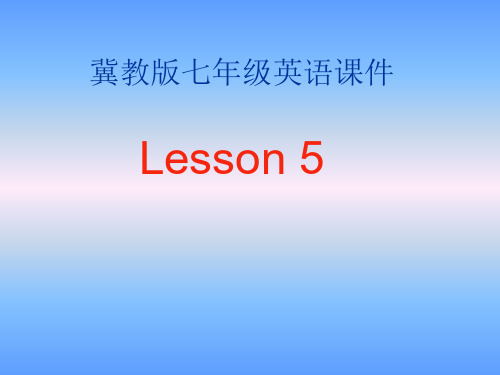
There are __se_v_e_n__ days in a week . __S_u_n_d_a_y___is the first day of the week. (星期天) __M_o_n_d_a_y___is the second day of the week.(星期一) _T_u_e_s_d_a_y___is the __th_i_rd__ day of the week.(星期二) _W__e_d_n_e_sd_a_y_is the _f_o_u_r_th_ day of the week.(星期三) __________is the ______ day of the week . __________is the ______ day of the week. __________is the ______ day of the week.
冀教版七年级英语课件
Lesson 5
教学过程 Step 1: Complete the following passage
There are _______ days in a week . __________is the first day of the week. __________is the second day of the week. __________is the ______ day of the week. __________is the ______ day of the week. __________is the ______ day of the week . __________is the ______ day of the week. __________is the ______ day of the week.
初二英语Student--Book-2(UNIT1—4)单元的重点知识
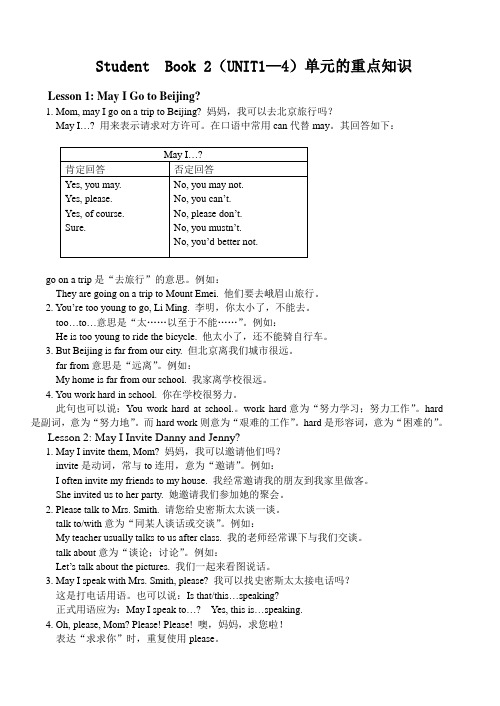
Student Book 2(UNIT1—4)单元的重点知识Lesson 1: May I Go to Beijing?1. Mom, may I go on a trip to Beijing? 妈妈,我可以去北京旅行吗?May I…? 用来表示请求对方许可。
在口语中常用can代替may。
其回答如下:go on a trip是“去旅行”的意思。
例如:They are going on a trip to Mount Emei. 他们要去峨眉山旅行。
2. You’re too young to go, Li Ming. 李明,你太小了,不能去。
too…to…意思是“太……以至于不能……”。
例如:He is too young to ride the bicycle. 他太小了,还不能骑自行车。
3. But Beijing is far from our city. 但北京离我们城市很远。
far from意思是“远离”。
例如:My home is far from our school. 我家离学校很远。
4. You work hard in school. 你在学校很努力。
此句也可以说:You work hard at school.。
work hard意为“努力学习;努力工作”。
hard 是副词,意为“努力地”。
而hard work则意为“艰难的工作”。
hard是形容词,意为“困难的”。
Lesson 2: May I Invite Danny and Jenny?1. May I invite them, Mom? 妈妈,我可以邀请他们吗?invite是动词,常与to连用,意为“邀请”。
例如:I often invite my friends to my house. 我经常邀请我的朋友到我家里做客。
She invited us to her party. 她邀请我们参加她的聚会。
2. Please talk to Mrs. Smith. 请您给史密斯太太谈一谈。
七年级英语下册 Unit1 A Trip to Beijing Lesson1-Lesson4重难点
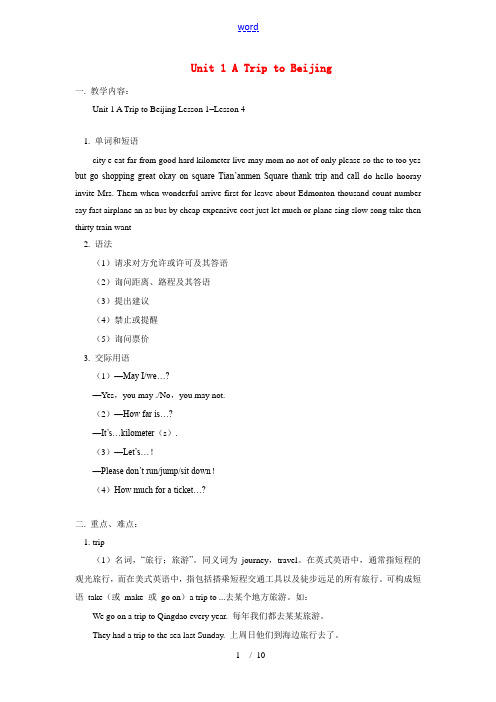
Unit 1 A Trip to Beijing一. 教学内容:Unit 1 A Trip to Beijing Lesson 1–Lesson 41. 单词和短语city e eat far from good hard kilometer live may mom no not of only please so the to too yes but go shopping great okay on square Tian’anmen Square thank trip and call do hello hooray invite Mrs. Them when wonderful arrive first for leave about Edmonton thousand count number say fast airplane an as bus by cheap expensive cost just let much or plane sing slow song take then thirty train want2. 语法(1)请求对方允许或许可及其答语(2)询问距离、路程及其答语(3)提出建议(4)禁止或提醒(5)询问票价3. 交际用语(1)—May I/we…?—Yes,you may ./No,you may not.(2)—How far is…?—It’s…kilometer(s).(3)—Let’s…!—Please don’t run/jump/sit down!(4)How much for a ticket…?二. 重点、难点:1. trip(1)名词,“旅行;旅游”。
同义词为journey,travel。
在英式英语中,通常指短程的观光旅行,而在美式英语中,指包括搭乘短程交通工具以及徒步远足的所有旅行。
可构成短语take(或make 或go on)a trip to ...去某个地方旅游。
英语:Unit-1-《A-Trip-to-Beijing.》Lesson5课件(2)(冀教版七年级下)
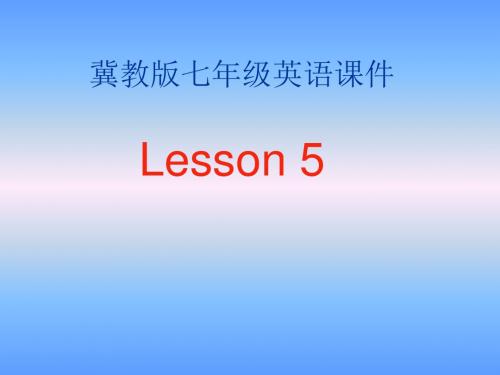
by 5. They are going there _____train .
; / 北京拓展基地 北京拓展训练 北京拓展培训公司
ory19msq
么的;也梦过几次我们和爹在汉口镇上开店,在娘娘家吃饭,大家一起说话,还有小青姐姐又撒小性子了。就是没有梦见过爹 给咱们说过什么,就是人常说的托梦什么的。”耿正说:“我也是啊,总是做一些没有什么特殊意义的梦。”耿直说:“咱俩 今儿个晚上又睡在这个屋子里了。若在天有灵,希望爹爹能回来告诉我们,他在哪里,我们回去了也„„”听着耿直已经带着 哭腔了,耿正伸手给弟弟掖掖被角,说:“睡吧。说不准等我们睡着了,爹真得就回来给我们托梦了呢!”耿直不再说话,过 一会儿也就沉沉地睡着了。耿正却辗转难眠,眼前总是在晃动着当年父子四人一同住在这个屋子里的情景„„耿英进了西边屋 里时,看到娘娘已经将两床被褥都铺好了,正坐在桌子边上等她呢。再一看,洗脚盆、干毛巾也都放在那里。耿英说:“娘娘, 您洗了?”乔氏说:“娘娘洗了。你快洗洗睡吧,明儿个一早还要赶路呢!”耿英说:“娘娘您先睡,我马上就好!”乔氏说: “那我先睡了。你洗完了什么也不要收拾,赶快上来睡觉!”“唔!”耿英答应着匆匆洗罢,快速脱了外衣钻进松软舒服的被 窝里。乔氏伸出手来给她掖掖被角,说:“我吹灯了啊!你闭眼睡吧,不早了!”耿英又听话地“唔”一声。灯熄灭了。在黑 暗中,耿英也是久久不能入睡。她假装睡着了,一动不动地侧卧在娘娘身边。但她很明显地感觉到,娘娘也并没有很快睡着了。 她时不时地尽量轻轻动一动,但始终再没有和耿英说话。耿英知道,娘娘不是没有想说的话,而是将许多想说的话都藏在心里 了„„后半夜了,在窗外一阵阵“呼呼啦啦”风声中,耿英终于沉沉地睡着了。第二天醒来,天已经大亮了。听见东伢子在过 厅里压低嗓音儿说:“姆妈,我买的是刚宰好的鱼!”乔氏说:“这样更好,我简单清洗一下就可以上笼蒸了!没你的事儿了, 去看小伢子吧!”东伢子说:“小伢子还没醒呢。我先去给大白骡再加点儿草料吧!”耿英赶快起床收拾,发现乔氏母女俩已 经将早饭准备大半了„„饱餐了香喷喷的清蒸武昌鱼拌新蒸米饭后,东伢子对乔氏说:“姆妈,我将骡车也套上,咱们送耿兄 弟他们去码头吧!”乔氏还未说话,耿正赶快说:“千万不可以!你们看,外面风很大呢,这一大早的天儿很冷呢。都不要远 送,就送门口!”耿英和耿直也说:“是的,千万不要远送。送到门口就好了!”乔氏想一想,说:“后半夜就起风了呢。也 好,就听你们的吧!”随后吩咐东伢子:“你记着把干粮袋子和酱菜放到车上啊!切好的酱牛肉我已经放到袋子里啦!”东伢 子说:“姆妈放心,我记着呢,已经放在过厅口上了!”耿英说:“娘娘,您怎么又准备了这些啊!”乔氏说:“你们姐夫早 上刚买的。已经买了,带上吧,万一过年了客栈里人少没有现
英语:Unit-1-《A-Trip-to-Beijing.》Lesson5课件(3)(冀教版七年级下
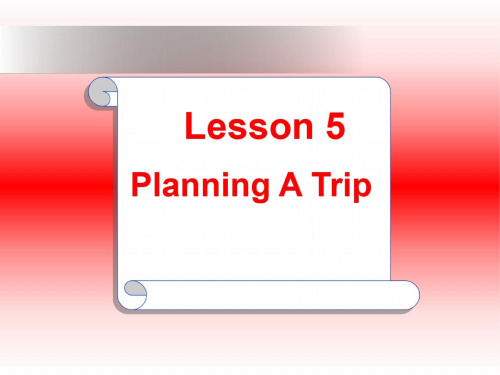
今年,因为一场突如其来的疫情,阴霾着天空,改变了许多人的生活轨迹。我也没有回应山一程水一程的邀约,去遇见那些迤逦在山水之间的艳粉娇红。于是,一月,我错过了梅舞霜天,盈雪回旋 的景致;二月,桃花春笺的邀请也没等到我的出现,在万径人踪灭的空山瘦水中,自顾自的美丽着;三月,乌山脚下的那两株樱花,朵朵的绯红,在望眼欲穿中,也没等到那个最爱它们的女子,施施然 地走过,独自地开了又落了;四月的木棉花,依然向晴空抒发着一腔的热血,只是少了那个娇小女子的喝采;五月,石榴半吐红巾蹙,芳心千重似束,左等右等,也不见我芳踪的出现,那个年年来拍照 的女子在哪里呢?一枝秾艳,日日只恐被秋风惊绿……光阴如水滑过,我安静于两点一线的生活,不敢旁生支路,再去看山看水看花草。为了减少新冠袭击的机会,我大部分都蛰伏在家中,看江山文学, 把那些开在字里行间,流年的花,温暖的遇见,看了一遍又一遍。
走过那山、那水、那些城,遇见那些花,那些人,拈来唯美温馨的文字,让这些遇见旖旎在字里行间,留存在温暖的江山文学网之中,与纸墨弥香,与时光共流转。回首经年,走进江山文学网,坐 在时光的水岸,打开自己的文集,点点行行,是高山仰止,景行行止的瞻望;是采菊东篱下,悠然见南山的闲情;是清波澹澹起,白鸟悠悠下的情致;是绿竹入幽径,青萝拂行衣的风雅;带着把酒话桑 麻,长歌吟松风的畅然,细数着过往的那些遇见,与时光陶然共忘机。3344555
七年级英语下册 Unit 1 A Trip to Beijing Lesson 5–
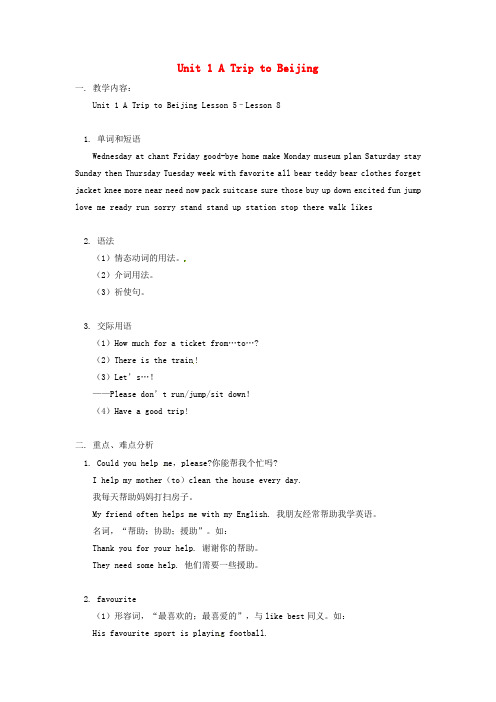
Unit 1 A Trip to Beijing一. 教学内容:Unit 1 A Trip to Beijing Lesson 5–Lesson 81. 单词和短语Wednesday at chant Friday good-bye home make Monday museum plan Saturday stay Sunday then Thursday Tuesday week with favorite all bear teddy bear clothes forget jacket knee more near need now pack suitcase sure those buy up down excited fun jump love me ready run sorry stand stand up station stop there walk likes2. 语法(1)情态动词的用法。
(2)介词用法。
(3)祈使句。
3. 交际用语(1)How much for a ticket from…to…?(2)There is the train!(3)Let’s…!——Please don’t run/jump/sit down!(4)Have a good trip!二. 重点、难点分析1. Could you help me,please?你能帮我个忙吗?I help my mother(to)clean the house every day.我每天帮助妈妈打扫房子。
My friend often helps me with my English. 我朋友经常帮助我学英语。
名词,“帮助;协助;援助”。
如:Thank you for your help. 谢谢你的帮助。
They need some help. 他们需要一些援助。
2. favourite(1)形容词,“最喜欢的;最喜爱的”,与like best同义。
最新-七年级英语下册 Unit 1 A Trip to Beijing全单元
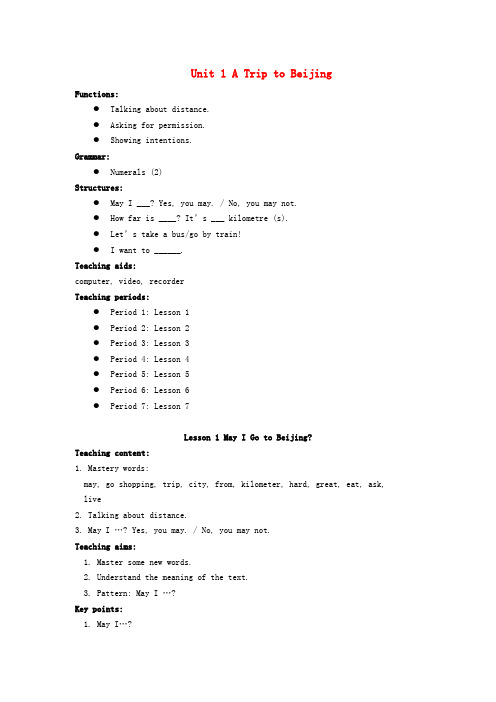
Unit 1 A Trip to BeijingFunctions:●Talking about distance.●Asking for permission.●Showing intentions.Grammar:●Numerals (2)Structures:●May I ___? Yes, you may. / No, you may not.●How far is ____? It’s ___ kilometre (s).●Let’s take a bus/go by train!●I want to ______.Teaching aids:computer, video, recorderTeaching periods:●Period 1: Lesson 1●Period 2: Lesson 2●Period 3: Lesson 3●Period 4: Lesson 4●Period 5: Lesson 5●Period 6: Lesson 6●Period 7: Lesson 7Lesson 1 May I Go to Beijing?Teaching content:1. Mastery words:may, go shopping, trip, city, from, kilometer, hard, great, eat, ask, live2. Talking about distance.3. May I …? Yes, you may. / No, you may not.Teaching aims:1. Master some new words.2. Understand the meaning of the text.3. Pattern: May I …?Key points:1. May I…?Yes, you may. / No. you may not.2. too…to…Teaching difficult points:the usage of “too…to…”Preparation:Prepare some pictures of Beijing.Teaching aids:Pictures and tape recorder.Type of lesson:Dialogue.Teaching Procedures:1.Class openingGreet the cl ass in English. Ask them some questions about their holidays such as “What did you do in your holiday? Were you busy in your holiday? Describe an interesting thing in your holiday.” Help them express the mselves. 2.New lessonStep 1. Lead inIntroduce the topic for Unit 1. Ask the class to discuss the questions in “Think about it”. First ask the students:Where did you go in your holiday?Did you go to Beijing? Where is Beijing?What direction is Beijing from our hometown?Which place is it in the picture? (Use some pictures such as Tian’anmen Square, Tiantan, and the Great Wall and so on.)Help them answer the questions.Step 2. Let the students listen to the tape of the dialogue with the following questions:Who will go to Beijing with Li Ming?What does Li Ming want to do in Beijing?Step 3. Answer the questions and discuss the dialogue with the class again. Deal with the language points at the same time (on the blackboard or the slide projector). Make sure they understand the meaning of the dialogue and know how to express distance and use May I…?Step 4. Play the audiotape again and have the students read after it.Step 5. PracticeAsk the students to read themselves .Walk around and deal with any question they have. Have them act out the dialogue in groups. Correct theirpronunciations at the same time.Step 6. Do the following exercises: Take a pen from a student and ask “May I use your pen?” help him answer “Yes, you may. / No, you may not.” And then let the students do the exercise in groups using some things on their desks. Step 7. ExercisesDo the exercises in the activity book.3. Class closing(1) Finish the activity book.(2) Read the text in Lesson 1.(3)The next reading in the student book.Lesson 2 May I invite Danny and Jenny?Teaching content:1. New words and expressions: invite, want, leave for, arrive in, invitation2. The usage of may and can.Teaching aims:1. Learn some new words.2. Understand the meaning of the text.3. Master the pattern: want sb. to do sth.4. Know how to use may and can.Teaching important points:The usage of talk to, leave for, arrive in, may and can.Teaching difficult points:The usage of may and can.Teaching aids:tape recorder and picturesType:New lessonTeaching procedures:1. Warming up(1) Greetings in English(2) duty report:One student talks about any subject he/she likes ever day. Theycan talk about the weather, the date and so on.(3) A brief review of yesterday’s lesson2. New lessonStep 1. Lead in: Take out some pictures of Tiananmen Square, Tiantan and so on and ask “Did you go to these places before? Do you want to go to TiananmenSquare?” Make sure the students understand the sentences and know how to answer t hem. Then come to the “Think about it” and discuss the questions together.Step 2. Listen to the tape of lesson 2 and answer the following questions: Who does Li Ming want to take to Beijing?Who does Mrs. Li ring?When will they leave for Beijing?Step 3. Answer the questions and discuss the dialogue together and make sure the students understand the whole text.Deal with the language points. Write “want…to…, talk to, leave for, invite” on the blackboard. Explain them and make some sentences to let them know how to use the words.Step 4. Play the audiotape again and have the students read after it.Step 5. Have the students read the text and act out in roles.Step 6. Have the students deal with “Let’s do it!”Step 7. Do exercise 1 in the activity book.3. Class closingLet’s our homework today(1)Finish the exercises in the activity book.(2)Read t he text of Lesson 2.(3)The next lesson in the student book.Lesson 3 How far is Beijing?Teaching content:1. some new words2. Numerals: thousand3. How far is…? It’s…kilometers.Teaching goals:1. Learn to express distance between two places.2. Master some numerals: thousand, hundred.Key points:How far is…?It’s… kilometers.Difficult points:Ask and answer about distance.Teaching aids:tape recorder, number cards, a mapType of lesson:dialogueTeaching procedures:1. Warming up1) Greetings in everyday English.2) Duty report3) Check the homework in lesson 2. Give them some explanation if necessary. 2. New lessonStep 1. Lead inAsk the following questions: How far is it from your home to your school?How far is it from our city to Beijing? Make sure the students understand the meaning and know how to answer the questions. Make them ask and answer in pairs.Step 2. Listen to the audiotape with the following questions:How far is it from China to Canada?Why is Mrs. Dinosaur worried?Step 3. Answer the questions and discuss the dialogue together with the students.Deal with any question the students have. Explain the expression of distance.Write some numbers on the blackboard.100 one hundred 1000 one thousand200 two hundred 2000 two thousand278 two hundred and seventy-eight2475 two t housand fou r hundred and fifty-sevenTeach the students how to read the numbers and make sure they can read different numbers. Take out some number cards and let them read the numbers out.Step 4. Play the tape again and have the students read after it.Step 5. Have the students read the dialogue and then act it out in roles.Step 6. Deal with “LET’S DO IT”Take out a map of your city. Practice asking the distance between two places.Use these sentences: Where is ________? How far is it from _____ to ______? Step 7. Do exercise 1 in the activity book.3. Class closingToday we learn how to express the distance. Now let’s come to our homework.(1) Finish off the exercise in your activity.(2) Read the text in lesson 3 fluently.Lesson 4 How Can We Go to Beijing?Teaching content:1. Mastery words: let, us, by, plane, take, bus, fast, slow, cheap, expensive, train, than, sing, songKnown words: cost, as, just2. a dialogue about going to Beijing3. an English song4. the Comparative Degree of adj.Teaching aims:1. Master some words above.2. Learn the usage of the Comparative Degree of adj.3. Can sing the English song?Key points:1. the usage of some words2. the Comparative Degree of adj.Difficult points:the Comparative Degree of adj.Preparation:word cards, tape, flashcardsTeaching aids:audiotape, slide projectorType of lesson:Dialogue and songTeaching procedures:1. Warming up① Greeting in everyday English.② Duty report③ Check up the homework in activity book, give explanation if necessary.2. New lessonStep 1. lead inDiscuss some questions in “THINK ABOUT IT”How do you go to school?How do you like to travel?Gather the answers from the students and compare the deferent ways and say which one is fast and which one is slow. Make them know faster and slower. Step 2. Listen to the text with the following questions.How does Li Ming like to travel?Which way is slower and which one is faster?Step 3. Answer the questions and discuss the whole dialogue. Make sure they understand the meaning of the dialogue. Deal with any question the stu dents have. Learn the language points at the same time. Write the important words on the blackboard such as fast, slow, cheap, expensive.Step 4. Listen to the audiotape again and let the students read after it.Step 5. PracticeHave the students read the dialogue by themselves. Walk around and help them read correctly. Then let them read the text in roles.Step 6. Let’s sing a song!Listen to the tape and then understand the lyrics. Explain when necessary.Then li sten to the tape again for several times to make sure the students can sing the song fluently.Step 7. A testLet him ______ there on such a rainy day.A. don’t goB. doesn’t goC. not goD. to goSally went to Shanghai ____ a plane.A. byB. withC. takesD. onBeijing is ___ of the two cities.A. biggerB. more biggerC. the biggerD. the more biggerA horse is ____ than a dog.A. much heavyB. more heavierC. much heavierD. more heavyStep 8. SummaryToday we learn a dialogue between Li Ming and his mom. We know they will go to Beijing by train. Train is faster than bus and is slower than plane. We learn the comparative degree of adj.Homework:1. Finish the exercises in your activity book.2. The next read ing in the students’ book.Lesson 5 Planning a TripTeaching content:1. New words:plan, make,need,week,home,Monday,Tuesday,Wednesday,Thursday,Friday,Saturday,Sunday2. A dialogue about Li Ming’s plan for their trip.3. Expression of week.4. Grammar: the Present Indefinite Tense for futureTeaching goals:1. Master the new words above.2. Learn and use the expression of week.3. Make plans for your life.Key points:the expression of weekDifficult points:the expression of weekTeaching aids:audiotape, flashcards, picturesType:dialogueTeaching procedures:1. Warming up1) Greet the students in everyday English and make sure they can responsecorrectly.2) Everyday report.3) Sing the song in Lesson 4 together.4) Check up the exercises in the activity book and explain when necessary. 2. New less onStep 1. Lead inTalk about the questions in “THINK ABOUT IT”Do you like to make plans for your life? Why or why not?Is there an interesting place in your town or city? What is it?Step 2. Listen to the tape of the dialogue with the following questions:What does Li Ming change in the plan?When will they go to the Great Wall?When will they go to the Palace Museum?After listening to the tape, answer the questions and understand the whole text. Deal with the language points at the same time. (Using the slide projector.)Step 3. Listen to the audiotape again and let the students read after it.Step 4. PracticeRead the dialogue by themselves. Make sure they read it correctly.Step 5. Have the students read the text in roles.Step 6. Let’s come to the second part of this lesson—Plan of Our TripRead the plan and pay attention to the pronunciation of the words of week. Step 7. A test (on the blackboard or the slide projector)用interest, interesting, interested填空1) His mother is _____ in buying beautiful clothes.2) He like to watch cartoons because he thinks it’s very _____.3) I began collecting stamps but soon lost _____.Step 8. Have the students deal with “LET’S DO IT”Homework:1. The exercises in the activity book.2. Read the text in lesson 5 fluently.3. The next reading in the student book.Lesson 6 Li Ming Packs His SuitcaseTeaching content:1. New words: pack, clothes, help, jacket, favourite, nice, all, done, near, this,that, these, those2. A dialogue about Li Ming’s packing his suitcase.Teaching goals:1. Master some new words.2. Learn the usage of pronouns: this, that, these, thoseKey points:this, that, these, thoseDifficult points:the usage of Demonstrative PronounsTeaching aids:audiotape, pictures of clothes or some real clothing, flashcards, slide projector Type:dialogueTeaching procedures:1. Warming up1) Greet the students in everyday English.2) Duty report3) Check yesterday’s homework.2. New lessonStep 1. Lead inWe learn t hat Li Ming will go to Beijing with Danny and Jenny. They makea plan for their trip. So today we will know what Li Ming will take withhim. First, let’s discuss some questions in “THINK ABOUT IT”:Do you have a suitcase? Is it big or small? What colour is it?When you go on a trip, what things do you like to take?Let some students answer the questions. Maybe they give many different answers.Step 2. Listen to the tape with the following questions:What does Li Ming need?Does Li Ming take only one shirt?Step 3. Answer the questions and look through the whole text. Deal with some language points (using flash cards and slide projector). Make sure the students understand the meaning of the dialogue.Step 4. Play the audiotape again and let the students read after it.Step 5. PracticeLet the students read the text aloud and the teacher walks around and deals with any question the students have. Then have them act out the dialogue in roles (using pictures or real clothes). Correct their mistakes if any. Step 6. Let’s chantListen to the recorder first and then read it together. Pay attention to the rhyme: far and star; near and ear; these and knees; those, toes and know.If you read in the right rhyme, you will read it beautifully. W rite “this, that, these, those” on the blackboard or use slide projector. Explain the difference between these words.Step 7. A test1) Fine ______ makes the man. (A)A. clothesB. clothC. clothesesD. cloth2) I helped him ____ his lost watch. (A)A. to findB. findingC. foundD. findsHomework:1. Finish the activity book in Lesson 6.2. Read the text fluently.3. Read the next reading in Lesson 7.Lesson 7 At the Train StationTeaching content:1. Mastery words: everyone, buy, ticket, excited, love, run, jump, down2. The expression of aski ng the price.3. The usage of Imperative Sentences.Teaching goals:1.Remember the mastery words.2.Understand the meaning of the text.3.Know how to ask the price.Teaching key points:1.Expression of asking the price and asking time.2.the usage of Imperative Sentences.Difficult points:the Imperative SentencesTeaching aids:audiotape, slide projectorType:a dialogueTeaching procedures:1. Warming up1)Greetings in English.2)Duty report.3)Brief review of the last lesson.2. New lessonStep 1. Lead inTalk about the questions in “THINK ABOUT IT”Do you like to take the train? Why or why not?What can you see at the train station?Gather the answers from the students.Step 2. Listen to the tape of the text with the following questions: How does Danny feel about the train trip?How much does Li Ming need to pay for their tickets?When does the train leave?Step 3. Listen to the tape again and let the students read after it.Step 4. Have the students read the text aloud for a few minutes. Then ask them act it out in roles. Correct their pronunciation when necessary.Step 5. Deal with “LET’S DO IT” and answer the questions:Do you sometimes get excited? What makes you excited? Do the exercise in pairs.If time permits, let them write a short passage and then read it out in class. Step 6. ExercisesDo the exercises in the activity book.Step 7. SummaryToday we learn a dialogue about Li Ming and his friends. They buy tickets and they are waiting the trai n at the train station. They are excited. From the text we know how to ask the price and we also know how to order other people to do something.Homework:1. Read the text in this lesson.2. Finish the exercises in the activity book.3. Read the next reading.。
- 1、下载文档前请自行甄别文档内容的完整性,平台不提供额外的编辑、内容补充、找答案等附加服务。
- 2、"仅部分预览"的文档,不可在线预览部分如存在完整性等问题,可反馈申请退款(可完整预览的文档不适用该条件!)。
- 3、如文档侵犯您的权益,请联系客服反馈,我们会尽快为您处理(人工客服工作时间:9:00-18:30)。
未曾谋面的龙红,站在了我面前。一袭火红的呢子大衣,裹着十分消瘦的身体,弱不禁风的样子,令我脑海焕出一幅画面:春风骀荡,陌上涌起了春烟,一朵无名的花,摇曳着,风在低语,却不见 花儿欢唱。哦,所谓“花之语”不是花儿说出,是让我们来解读。她是一朵蒲公英?随风的花絮,弥漫在陌上,无需歌咏她的生命力,因为她要摇曳一段最美的花之姿。蒲公英的美在于飞舞,斩断了种 子与母体的脐带,依然要飞舞着,找到繁衍的土地。可我又担心花絮滑翔跌宕,落地生疼。我又希望她就是花瓣上的一滴露,却又怕轻风一袭而垂落……
她对于江山的认识,和我的不一样。她告诉我,她找到了一个随时可以与人说心里话的地方。她没有奢望,只有一个不起眼的要求,一点也不过分。她的话,让我感到辛酸,同时也热透了心。我们 平时要求的甚多,不容易满足,可能我们还真没有遇到坎坷,多点坎坷,就会减少一点过分,是这样的道理啊!我想到一篇文章《假如给我七天光明》,假如可以给她唱歌的权利……我很理解一个被喉 癌折磨十几年的人,是怎样的生活心态了。一个正常的人,多是无法理解非常人的心意和渴求的。她用文字弥补了失声的苦痛与限制,她找到了自己的扩音器。我这样想。手机游戏免费下载
痛苦,我们无法与人承受,那就和人一起享受在我们看来不算快乐的快乐吧。所以,龙红的文章传来,我要ห้องสมุดไป่ตู้自为她编辑,这是我与她对话的时刻,我想,她和我一样,都很期待和珍惜。
江山啊,如此说来,在某些人看来只不过是找到一处消遣的所在,而在我们,则是找到一处用文字来止痛的疗养院。她说我是一个先行探界者,我一阵振臂,就招来了她这个追随者。其实,文字止 痛,是我们的共识。她满意地说,找到了一个有温度的地方。
